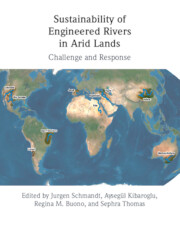Book contents
- Sustainability of Engineered Rivers in Arid Lands
- Sustainability of Engineered Rivers in Arid Lands
- Copyright page
- Dedication
- Contents
- Contributors
- Part I Introduction
- Part II Challenge
- Part III Engineered Rivers
- 7 The Nile River Basin
- 8 The Euphrates–Tigris River Basin
- 9 The Yellow River Basin
- 10 The Murray–Darling River Basin
- 11 The São Francisco River Basin
- 12 The Limarí River Basin
- 13 The Colorado River Basin
- 14 The Rio Grande / Río Bravo Basin
- 15 The Jucar River Basin
- Part IV Response
- Part V Conclusion
- Index
- References
15 - The Jucar River Basin
from Part III - Engineered Rivers
Published online by Cambridge University Press: 16 September 2021
- Sustainability of Engineered Rivers in Arid Lands
- Sustainability of Engineered Rivers in Arid Lands
- Copyright page
- Dedication
- Contents
- Contributors
- Part I Introduction
- Part II Challenge
- Part III Engineered Rivers
- 7 The Nile River Basin
- 8 The Euphrates–Tigris River Basin
- 9 The Yellow River Basin
- 10 The Murray–Darling River Basin
- 11 The São Francisco River Basin
- 12 The Limarí River Basin
- 13 The Colorado River Basin
- 14 The Rio Grande / Río Bravo Basin
- 15 The Jucar River Basin
- Part IV Response
- Part V Conclusion
- Index
- References
Summary
The Jucar Basin faces the challenge of meeting an enormous demand for irrigation while water quality degrades from urban, industrial, and agricultural pollution. Relying on engineering solutions is not enough. Empirical evidence in Jucar indicates that water markets and institutional policies seem to deal with water scarcity more successfully than water pricing and irrigation subsidies. A first water governance priority is to convince farmers of substituting freshwater for the available urban recycled water. Second, seawater desalination plants must be upgraded so they will work at full capacity. More long-term governance goals are to curtail surface irrigation diversions and groundwater extractions, and reallocating water to urban, industrial, and environmental uses. These reforms will only work if they get the support and cooperation of farmers by compensating them for the reallocation of water from agriculture to other sectors.
Keywords
- Type
- Chapter
- Information
- Sustainability of Engineered Rivers In Arid LandsChallenge and Response, pp. 220 - 232Publisher: Cambridge University PressPrint publication year: 2021
References
- 1
- Cited by

